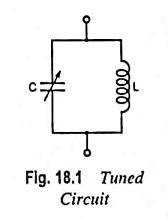Tuned Amplifiers – Definition, Classification and Advantages:
Amplifier amplifying a signal of specific frequency or narrowband of frequencies is known as tuned amplifier. Tuned amplifiers are mostly employed for amplification of high or radio frequency signals, because radio frequencies are generally single and tuned circuits permit their selection. Such amplifiers cannot be used for amplification of audio-frequency signals because of the following reasons :
- A tuned amplifier selects and amplifies a single frequency while audio frequencies are mixtures of frequencies in the frequency range of 20 Hz – 20 kHz and are not single. It is desired that all these frequencies should be equally amplified for proper reproduction of the signal. So tuned amplifiers cannot be used for this purpose.
- For amplification of low frequency signals large valued inductors and capacitors (L and C) are required and this makes the tuned circuit bulky and expensive.
It is noteworthy here that R-C coupled and transformer coupled amplifiers, which are comparatively cheap, can be conveniently employed for amplification of low frequency signals.
Such amplifiers are widely used in radio and TV circuits where radio frequency signals are to be handled.
A tuned amplifier employes a tuned circuit as shown in Fig. 18.1. Because of the well-known phenomenon called resonance, the tuned circuit is capable of selecting a particular or relatively narrowband of frequencies. The centre of this frequency band is the resonant frequency of the tuned circuit.
Resonant L-C circuit as a load provides high impedance and so the tuned transistor amplifiers can provide high gain because gain of a transistor amplifier depends directly on the value of its load impedance.
The frequency response curve of the amplifier assumes the same shape as the resonance curve of the tuned circuit. Obviously, only a narrowband of frequencies around the resonant frequency fr would be amplified well while other frequencies would be discriminated against.
The difference between the tuned amplifier and other amplifiers is that tuned amplifiers are designed for specific, usually narrow, bandwidth.
Classification of Tuned Amplifiers:
Tuned amplifiers, like audio amplifiers, may also be divided into two categories viz small signal tuned amplifiers and large signal tuned amplifiers. Small signal tuned amplifiers are used for amplification of small signals at radio frequencies and operated under class A operation as power involved is small. In class A operation, as already known, distortion is negligibly small. Large signal tuned amplifiers are employed for amplification of large signals, at radio frequencies. These amplifiers are operated under class B or class C operation because of involvement of large power. But in tuned circuits nonlinear distortion is eliminated because of high selectivity of the load impedance, and therefore, output is nearly sinusoidal. With the removal of distortion high amplifier efficiency can be achieved by operating the transistor in its nonlinear region.
Small signal tuned amplifiers may further be classified into single tuned amplifiers and double tuned amplifiers. In single tuned amplifier, one parallel tuned circuit is employed while in double tuned amplifier, two inductively coupled tuned circuits are employed per stage and both tuned circuits being tuned to the same frequency.
Advantages of Tuned Circuits:
- High Selectivity: The tuned circuit is capable of selecting the desired frequency for amplification out of a number of frequencies simultaneously impressed upon it.
- Small Collector Voltage: Because of negligibly small resistance in the parallel tuned circuit, it requires small collector supply voltage VCC.
- Small Power Loss: The power loss in a tuned circuit is quite small because it consists only reactive components such as L and C.
Inspite of all these advantages, tuned amplifiers cannot be employed for amplification of low frequencies. This is because (i) the low frequencies are never single, as they are mixtures of frequencies in the range of 20 Hz – 20 kHz and (ii) reactive components L and C required for amplification of low frequencies are of larger values and, therefore, tuned circuit becomes bulky and expensive.
